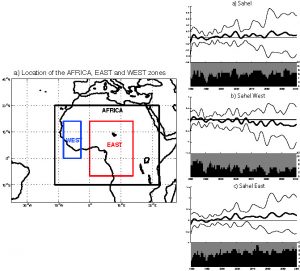l’article du mois – avril 2012
 Mid-century effects of Climate Change on African monsoon dynamics using the A1B emission scenario
Mid-century effects of Climate Change on African monsoon dynamics using the A1B emission scenario
par Paul-Arthur Monerie, Pascal Roucou et Bernard Fontaine
Accepté dans la revue International Journal of Climatology
Future climate changes in African regions are model-dependent and there is no consensus regarding Sahelian rainfall by the end of this century. Using 12 AOGCMs of the third Coupled Model
Intercomparison Project (CMIP3) we propose a multi-model analysis contrasting the 1960-1999 period (20c3m integration) and the 2031-2070 period (A1B emission scenario). The analyses are
based on multi-model response but also on the ‘one model-one vote’ concept to give the same weight to each model. The results show robust signals in the rainfall response, i.e., increasing
(decreasing) amounts in central (western) Sahel associated with specific changes in atmospheric dynamics. The rainfall excesses expected in central Sahel are mainly linked to an enhancement of the northern Hadley-type cell and probably to its northward shift. At low-levels increasing temperature and evaporation strengthen the monsoon flux. Rainfall deficits predicted westward are
due to a reinforcement of the African Easterly Jet and to anomalies in the zonal circulation between the Indian and the Atlantic Oceans, favouring air subsidence and moisture export outside the region. The weakening of the meridional circulation is also able to prevent rainfall amounts in the western part of the Sahel. More generally, these analyses show that in future works the Sahel region must not be considered as one consistent region but as two separate areas, both sides of the Greenwich meridian. The authors propose to consider this feature in the next Fifth Assessment cycle (AR5) in order to better understand the impacts of the climate change on West Africa.
- extrait:
- lien_externe:
- kc_data:
- a:8:{i:0;s:0:"";s:4:"mode";s:0:"";s:3:"css";s:0:"";s:9:"max_width";s:0:"";s:7:"classes";s:0:"";s:9:"thumbnail";s:0:"";s:9:"collapsed";s:0:"";s:9:"optimized";s:0:"";}
- kc_raw_content:
 Mid-century effects of Climate Change on African monsoon dynamics using the A1B emission scenario
Mid-century effects of Climate Change on African monsoon dynamics using the A1B emission scenariopar Paul-Arthur Monerie, Pascal Roucou et Bernard Fontaine
Accepté dans la revue International Journal of Climatology
Future climate changes in African regions are model-dependent and there is no consensus regarding Sahelian rainfall by the end of this century. Using 12 AOGCMs of the third Coupled Model
Intercomparison Project (CMIP3) we propose a multi-model analysis contrasting the 1960-1999 period (20c3m integration) and the 2031-2070 period (A1B emission scenario). The analyses are
based on multi-model response but also on the 'one model-one vote' concept to give the same weight to each model. The results show robust signals in the rainfall response, i.e., increasing
(decreasing) amounts in central (western) Sahel associated with specific changes in atmospheric dynamics. The rainfall excesses expected in central Sahel are mainly linked to an enhancement of the northern Hadley-type cell and probably to its northward shift. At low-levels increasing temperature and evaporation strengthen the monsoon flux. Rainfall deficits predicted westward are
due to a reinforcement of the African Easterly Jet and to anomalies in the zonal circulation between the Indian and the Atlantic Oceans, favouring air subsidence and moisture export outside the region. The weakening of the meridional circulation is also able to prevent rainfall amounts in the western part of the Sahel. More generally, these analyses show that in future works the Sahel region must not be considered as one consistent region but as two separate areas, both sides of the Greenwich meridian. The authors propose to consider this feature in the next Fifth Assessment cycle (AR5) in order to better understand the impacts of the climate change on West Africa.
